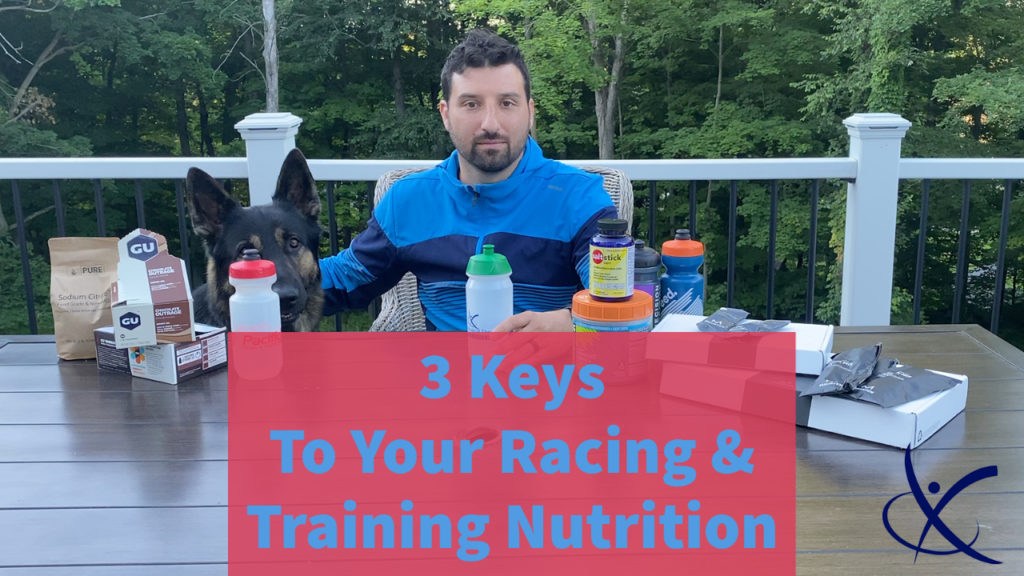3 Things That Can Cause Gut Distress While Training
I’ve been in the endurance game since 2010 and by now I’ve lost count of how many nutrition companies are in the market. But one thing is for sure:
Not all products work for everyone.
I started thinking about why this is and that led me down the rabbit hole of proper endurance nutrition. Fast forward a few months and I’m feeling really good about my own running/cycling nutrition, but I’ve also become confident in problem-solving the game within the game: how to plan the proper fueling strategies (Big thanks to Dr. Alex Harrison PhD over at Alacrity Endurance).
“Oh I can’t use that stuff it messes with my stomach” (or its variants) is all too common when discussing fueling strategies with my clients. I used to believe this, especially because I’m a picky eater myself. Now I’m finding that it’s probably a user error causing the gut issues while running and cycling and not the product itself. It’s not for lack of trying either; it’s just that most athletes aren’t aware of the breakdown and requirements for proper fueling strategies, leading to big issues. And the bottom line is common problems occur commonly.
So what’s the issue? Why do so many endurance athletes suffer from gut distress while training and racing? The main reason is an inadequate balance of the three main players in the fueling equation: Carbohydrates, sodium, and fluid. Yes, there is a certain amount of each and if that equation is off, it can and will lead to issues. Think of it like this: a car engine needs a certain mixture of gas, oil, and air to combust properly. If that mixture is off, the engine won’t function correctly. This is exactly how our stomach works.
Carbs act as our fuel for exercise. Proper fluids are necessary to increase blood plasma to help stay hydrated and deliver fuel. And sodium acts to keep the blood plasma volume instead of the fluids going straight to your kidneys and bladder for waste. By the way, blood plasma volume is one of the most important elements of cardiovascular exercise. With too little sodium the fluid bypasses the muscles and the athlete ends up peeing out the fluid instead of keeping it where it needs to be. This just leads to further dehydration and gut issues because you’re not actually absorbing any of the fluid you are intaking. Blood plasma volume stays low and fatigue sets in earlier.
When you exercise, blood and fluids are directed towards your extremities and working muscles. There isn’t a lot to spare for your stomach to digest. This is why too much caloric intake can be an issue during training/racing. There isn’t sufficient energy or resources to “take care of” what’s in your stomach and intestines. This is why super-concentrated drinks or foods can cause GI distress. While the need for carbs is high, there must be sufficient fluid intake to make the concentration manageable for the gut. This can occur with super concentrated bottles of mixed drinks (ask me how I know) or in a scenario where the athlete consumes plenty of chews, GUs, gels, blocks, etc. but doesn’t intake enough fluid volume to match. The carbs are good, but they must be consumed in a manner in which your body can digest and use them.
Ultimately, these are two of the more common pitfalls athletes become victim to.
- Too many carbs without enough fluid (either through a high concentration of carbs or through insufficient fluid intake)
- Not enough sodium to maintain blood plasma/hydration status and facilitate energy delivery.
Now that we’ve addressed the common mishaps, think about all of those different companies with their own proprietary blends. They will often have different amounts of carbs per serving, different types of carbs per serving, and varying amounts of sodium per serving. And if it’s a drink mix, the ratio of these nutrients per liter of fluid is also going to affect your “ideal” requirements for racing/training.
As I mentioned, gut distress is often user error but not for lack of trying. Most individuals don’t know what to look for or how to calculate their needs. So instead of a certain product not agreeing with them, perhaps it’s too little fluid or too little sodium causing the issues. I might suggest looking at the labels of those products you’ve been using and start to get a sense of how many carbs (in grams) and sodium (in MGs) you’ve been consuming during long runs/rides/bricks. Now, how about that fluid volume? How much have you been drinking?
I’m not going to discuss how much of each you “need” just yet. That’s for another day. For now, it’s important to see if you have any low-hanging fruit that can be picked to reduce GI distress or simply improve performance overall.
Happy Training!
John
